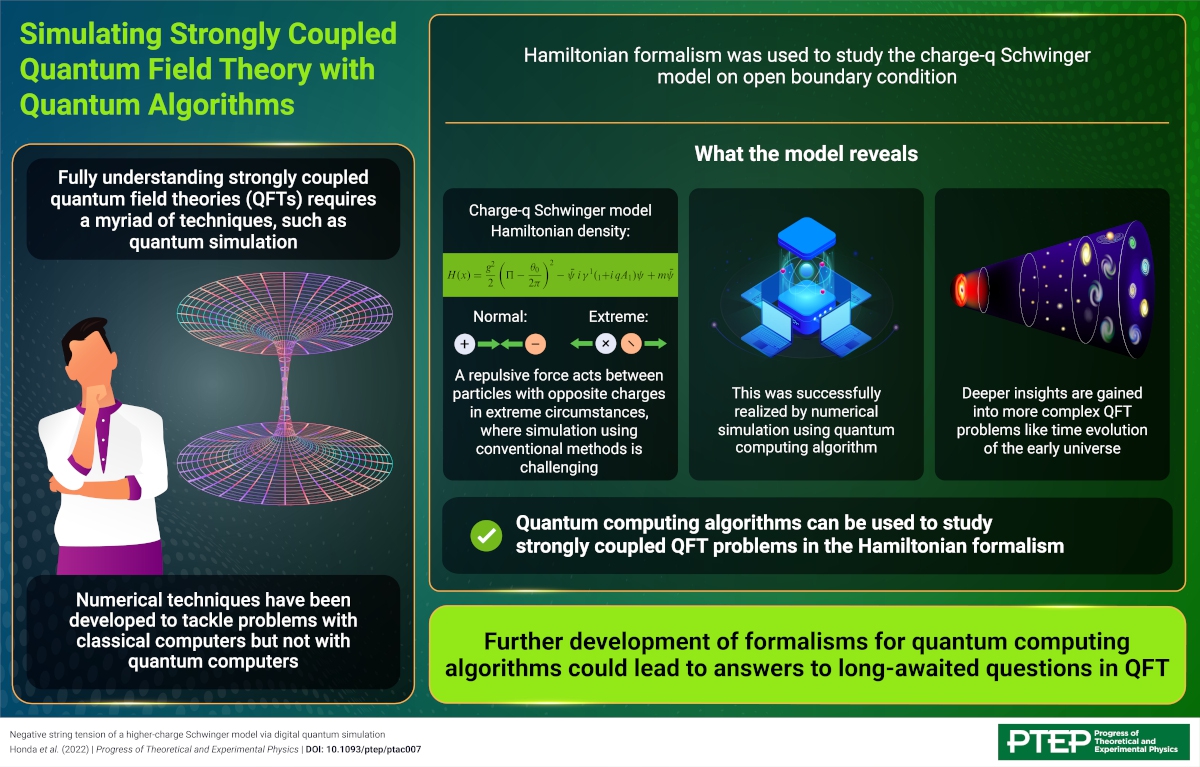Simulating Strongly Coupled Quantum Field Theory with Quantum Algorithms
© The Physical Society of Japan
This article is on
Negative string tension of a higher-charge Schwinger model via digital quantum simulation
(PTEP Editors' Choice)
Prog. Theor. Exp. Phys. 2022, 033B01 (2022).
Nonperturbative quantum field theory problems can often be difficult to solve with classical algorithms. Researchers now develop quantum computing algorithms to understand such problems in the Hamiltonian formalism.

Quantum field theory (QFT) is an over-arching theoretical framework that combines classical field theory, special relativity, and quantum mechanics under the same umbrella. While weakly coupled QFT problems have been solved and understood with current methods and techniques, strongly coupled QFTs remain elusive. Such problems can be tackled using numerical computation techniques. One such technique is “quantum simulation.”
Unfortunately, numerical techniques developed to tackle problems have had limited success with classical algorithms. Such methods are either non-efficient, lack accuracy, or are too specific and cannot be generalized to other problems. Interestingly, quantum computing algorithms have remained largely unexplored, partly because quantum simulations are usually performed using the Hamiltonian formalism. Moreover, techniques for applying quantum simulation using quantum computers are yet to be developed.
In this work, the charge-q Schwinger model on the open boundary condition was studied in the Hamiltonian formalism instead of the more commonly used path-integral formalism. The Hilbert space in the model is known to be decomposed into distinct sectors, called “universes.” The developed method was based on the so-called “adiabatic state preparation,” allowing the problem to be solved with a digital quantum simulation.
The model revealed that a repulsive force acts between particles with opposite charges, contrary to the traditional classical attraction, in particular circumstances. This observation was confirmed using a classical simulator of quantum devices. Predicting this phenomenon with a quantum computing algorithm, thus, demonstrated their potentially superior capability in handling strongly coupled QFT problems.
Quantum computing methods like these can be used to gain deeper insights into more complex QFT problems, such as the time evolution of the early universe. Such problems have long intrigued scientists but have remained intractable owing to the lack of adequate solving techniques.
The findings of this study open doors to further development and applications of quantum computing algorithms in QFT. This could lead to answers to long-awaited questions in QFT, broadening our understanding of the universe.
Negative string tension of a higher-charge Schwinger model via digital quantum simulation
(PTEP Editors' Choice)
Prog. Theor. Exp. Phys. 2022, 033B01 (2022).
Share this topic
Fields
Related Articles
-
Quantum Mechanics of One-Dimensional Three-Body Contact Interactions
Mathematical methods, classical and quantum physics, relativity, gravitation, numerical simulation, computational modeling
Theoretical Particle Physics
2024-2-13
The quantum mechanical description of topologically nontrivial three-body contact interactions in one dimension is not well understood. This study explores the Hamiltonian description of these interactions using the path-integral formalism.
-
Investigating Unitarity Violation of Lee–Wick’s Complex Ghost with Quantum Field Theory
Theoretical Particle Physics
2024-1-19
Theories with fourth-order derivatives like Lee–Wick’s quantum electrodynamics model or quadratic gravity result in complex ghosts above a definite energy threshold that violate unitarity.
-
Investigating Δ and Ω Baryons as Meson–Baryon Bound States in Lattice Quantum Chromodynamics
Theoretical Particle Physics
2023-7-13
We investigate Δ and Ω baryons as meson–baryon bound states in lattice quantum chromodynamics and show that their difference results from the kinematic structure of the two meson–baryon systems, and not their interaction.
-
Novel Insights Into Bulk Reconstruction in the Anti-de Sitter/Conformal Field Theory Correspondence
Theoretical Particle Physics
2023-6-1
Bulk reconstruction in anti-de Sitter/conformal field theory is fundamental to our understanding of quantum gravity. We show that contrary to popular belief, bulk reconstruction is rather simple and intuitive.
-
The Stolz–Teichner Conjecture and Supermoonshine
Theoretical Particle Physics
2023-4-25
We check the validity of the "divisibility property," predicted by the Stolz–Teichner conjecture, for several infinite families of theories built from Duncan’s Supermoonshine module. Along the way, we develop the tools necessary to construct the so-called "periodicity class."
